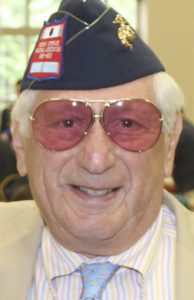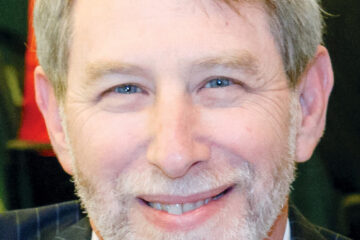For 3rd time in 13 years, temple votes down flags in sanctuary

Story And Photos By Marshall Weiss, The Dayton Jewish Observer
In a vote of 46 to 44 on May 7, Temple Israel congregants decided to keep the flags of the United States and Israel in the lobby of its building, rather than move them to the front of the main sanctuary.
The vote marks the third time since 2004 that Temple Israel’s membership has rejected a formal request to bring the flags to the main sanctuary, where they would be visible during worship services.
All three times, that request was brought by Temple Israel member Franklin T. Cohn, a U.S. Marine veteran of the Korean Conflict. Not a shrinking violet, Cohn, 83, was a driving force behind the Ohio Korean War Veterans Memorial, which opened in 1995 on Riverside Drive, adjacent to Temple Israel; the temple had moved there the previous year.
“To me, arguments against the flags are so insignificant for the people who have given their lives for this country,” Cohn says. “It’s our flag, it’s Israel’s flag. I also feel that the Jewish people were given a deed to Israel — given the land, and it’s written in the Torah.”
At Temple Israel’s annual meeting in 2004, Cohn moved that American and Israeli flags be placed on the bima (stage of the sanctuary) at Temple Israel; the motion was defeated by a two-thirds margin. This was after Cohn had first brought his request to the temple’s worship and music committee, where it was rejected; the committee’s recommendation to reject his request was then approved by the full board.
In October 2007, with a petition signed by more than 20 congregants as per the temple’s bylaws, Cohn called a congregational meeting to vote on his motion for flags on the bima. That time, the congregation voted against the motion 56 to 48, with one abstention.

Rabbi Karen Bodney-Halasz was the congregation’s director of education at the time of the 2004 and 2007 votes. She remembers how divisive and emotional the process became.
Now, as Temple Israel’s senior rabbi, she hoped to broker a compromise between the parties, and above all else, keep the civility and peace of her congregation.
“The question needs not to be whether the flags belong there (in the sanctuary), but how do we live with each other when we have differing opinions? That’s the way I’ve tried to frame it,” Bodney-Halasz says.
Attempted compromise
When Cohn submitted his latest petition in August 2016 requesting another congregational meeting and vote, the rabbi worked with him and the temple’s worship and music committee to identify an option both could live with.
The committee members and Cohn ultimately agreed that placing a flag next to each side of the bima would be acceptable.
With that, Cohn withdrew his original petition for the flags on the bima and submitted a revised petition to have them on either side of the bima.
“She was trying to create peace, so I agreed,” Cohn says of Bodney-Halasz. “Even if I compromised, they would be up front. I said, ‘Rabbi, if that will create peace, then I’m all for it.’”
The worship and music committee recommended the board vote to approve Cohn’s revised petition, which would have avoided a full congregational vote.
Prior to the board’s vote, Bodney-Halasz explained the nature of the compromise to her congregants in the temple’s newsletter.
“As is the case with consensus, this proposal is not ideal to anyone in those groups, but so far, everyone has agreed that they would be able to live with and respect this position,” she wrote.
Days before the board vote, Bodney-Halasz also brought two scholars from the Reform movement to talk with congregants about flags in Reform congregations. Members learned that within the Reform movement, each congregation must decide this issue for itself, and that both positions are equally acceptable.
When Temple Israel’s board voted on the revised compromise recommendation, it split nine to nine. Because of the temple’s bylaws, the decision went to the full congregation.
“There were no inflammatory remarks,” Bodney-Halasz says of the May 7 congregational meeting and vote. “We began the meeting with a prayer and discussion of what it means to have disagreements or arguments for the sake of Heaven, and reminding ourselves to be respectful.”
One congregant who spoke against placing the flags in the sanctuary at the May 7 meeting was Joel Shapiro.
“I did advise at the beginning that it was not a major issue,” Shapiro says. “First of all, I don’t see why patriotism is better served with flags in the sanctuary as when they are not. There is a question of distractions. If you’re looking at flags, that detracts you from the purpose for which you are there.”
Shapiro says another issue would have been the “atrocious placement” of the flags at the far ends of the front of the sanctuary, “in the corner, by the garbage.”
“The interesting thing about this is that it didn’t divide along liberal or conservative views, it didn’t divide between those who study and those who don’t,”
Shapiro adds. “There was really no segment that you could say: this type of people voted this way, and that type of people voted the other way.”
Among those who spoke at the congregational meeting were two temple members who had escaped Nazi Europe: one spoke for flags in the sanctuary, the other against.
“I said that I am an immigrant, and during my life, I’ve been stateless twice,” Dr. Felix Garfunkel says. “Therefore, the flag is significant to me. It’s hard to understand that people have difficulty worshipping when the flag is there. And I was wondering if this could be a touch of religious zealotry or extremism.” He also said the design of the Israeli flag represents a tallit (prayer shawl), and that is significant in the synagogue.
Eleanor Must also told the gathering that she was a stateless refugee of Nazi Europe. “I strongly value the separation of church and state that we have in this country and I don’t think at a time of worship that it’s appropriate to have national flags in the sanctuary,” Must said at the meeting.

Though it doesn’t call itself a synagogue, Chabad of Greater Dayton conducts worship services and doesn’t display flags. As Chabad’s Rabbi Nochum Mangel has previously said, “The synagogue transcends all nationalities.”
Bodney-Halasz notes that over the 14 years she’s been at Temple Israel, families have been able to request that the flags be brought into the sanctuary for a loved one’s funeral or memorial service.
According to Temple Israel’s incoming president, Carol Finley, who just attended a conference for new temple presidents hosted by the Reform movement, approximately 80 percent of Reform congregations display flags in their sanctuaries.
When Temple Israel was located at Salem and Emerson Avenues, the U.S. flag was displayed on the bima of its “community house” sanctuary before the congregation built a new main sanctuary on the campus in 1953.
Finley theorizes that neither the U.S. nor the Israeli flag were displayed in the 1953 sanctuary as not to draw attention to the absence or presence of the Israeli flag.
A strong segment of Reform Jews didn’t support Zionism in the early years of the Jewish state. In 1954, the Reform movement’s Central Conference of American Rabbis issued a responsa that stated, “…the Israeli flag is quite out of place in an American synagogue,” a position CCAR didn’t rescind until 1977.
With Temple Israel’s move to Riverside Drive in 1994, it continued the custom established in 1953 of no flags in the sanctuary. In 2004, they were placed in the lobby.
When Cohn returned to Dayton in 1956 after his discharge from the Marines, he says he mentioned the absence of flags on the bima to rabbis occasionally, but didn’t do anything about it.
“At that particular time, I didn’t have the feeling,” he says. “Later on, as I grew older, things happened. I felt that when a veteran died in any war, that even the comfort of having the American and Israeli flags in the sanctuary, to me, was meaningful. The families shouldn’t have to request that the flags be there for a funeral.”
Bodney-Halasz says she attempted to move the conversation away from precedent.
“The fact that we’re a congregation that grows and changes is a positive thing. It’s OK for us to examine our position on things from time to time,” she says.
“Three other Reform congregations in North America have just gone through the same flag issue as Temple Israel,” Finley says. “In each case, the effort was led by veterans and was voted down.”
One Temple Israel congregant whose view on the flag issue has changed since 2007 is Richard Saphire.
“I felt less strongly about the need to keep a flag out than I thought the proponents felt about the need to keep it in,” Saphire says. “If there were flags in the sanctuary it wouldn’t bother me, I’d probably get used to it. It was better to work out some sort of compromise for the peace and harmony of the congregation. We have enough stuff to deal with in Reform Judaism and the Jewish community in Dayton rather than spend a lot of time dealing with stuff like this.”
Cohn likens the outcome of the May 7 vote rejecting flags in the sanctuary to the turnout for a zoning meeting.
“The people who were against flags in the sanctuary came to the meeting,” he insists. “The people who were for it stayed at home. To me, it’s laziness.”
He says he’ll continue on as a lifelong member of Temple Israel; at some point, he’ll bring up the flag issue again, though he gives no time frame.
“I’m sure there are a lot of people who are going to think of me in a different way, and they’re probably not happy with me,” Cohn says.
An air of civility
A consensus among those interviewed for this story is that this time around, the proceedings were civil.
“The rabbi handled this with so much tact and diplomacy throughout the whole thing,” says Linda Novak, who sits on the worship and music committee and is its incoming chair. “She tried very much to avoid having any disruption in the family of the congregation.”
Saphire says Bodney-Halasz did all that she could have done to keep the peace.
“I think she deserves a lot of credit and so does Bart (outgoing temple president Bart Weprin), for handling this in the most sensitive way, and trying to make everybody feel as if they mattered in this, that their voices were heard. In that sense, it makes her come out of this stronger.”
To read the complete June 2017 Dayton Jewish Observer, click here.





